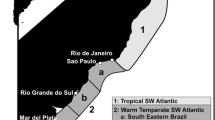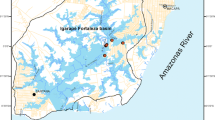Abstract
Information on the distribution and abundance patterns of trematodes are essential to reveal the ecology of host–parasite interactions. The Western Ghats of India, a biodiversity hotspot, is rich in freshwater fish diversity and endemism. Though there are several studies on various other aspects of fish ecology, studies on their parasitic fauna is meager. The objective of the present study is to explore the distribution and infection patterns of metacercariae of five species of trematodes in the freshwater fishes, Haludaria fasciata and Pseudosphromenus cupanus. The infection parameters were analyzed for each host and CART model was applied to analyze the environmental factors affecting parasite distribution patterns. All species of metacercariae showed an over-dispersed aggregate distributions. The classification tree models indicated that among the environmental factors considered, differences in host locality was the most influential factor in both fishes, followed at a greater distance by the factor seasonality. The parasite communities exhibited temporal and spatial differences in the infection pattern in response to seasonal and locational variations.






Similar content being viewed by others
References
Alexander N (2012) Analysis of parasite and other skewed counts. Trop Med Int Health 17(6):684–693
Anderson RM, May RM (1978) Regulation and stability of host-parasite population interactions. I. Regulatory precesses. J Anim Ecol 47:219–247
Begon M, Townsed CR, Harper JL (2006) Ecology. from individuals to ecosystems, 4th edn. Blackwell Publishing, Hoboken
Biggeri A (2005) Negative binomial distribution. In: Armitage P, Colton T (eds) Encyclopedia of Biostatistics, vol 5, 2nd edn. Wiley, Chi Chester, pp 3625–3630
Blakeslee AMP, Altman I, Miller AW, Byers JE, Hamer CE, Ruiz GM (2011) Parasites and invasions: a biogeographic examination of parasites and hosts in native and introduced ranges. J Biogeogr. https://doi.org/10.1111/j.1365-2699.2011.02631.x
Blasco-Costa I, Koehlern AV, Martin A, Poulin R (2013) Upstream-downstream gradient in infection levels by fish parasites: a common river pattern? Parasitology 140:266–274
Bolker BM (2008) Ecological models and data in R. Princeton University Press, Princeton, p 396
Breiman L, Friedman JH, Olshen R, Stone CJ (1984) Classification and regression trees. Wadsworth International Group, Belmont, CA
Bush AO, Lafferty KD, Lotz JM, Shostak AW (1997) Parasitology meets ecology on its own terms: Margolis et al. revisited. J Parasitol 83(4):575–583
Chakraborty A, Rumki S, Koushik G (2017) An inventory of endemic fish species in India with notes on state-wise distribution and conservation measures. Int J Fish Aquat Stud 5(1):253–264
Chipeta MG, Ngwira BM, Simoonga C, Kazembe LN (2014) Zero adjusted models with applications to analyzing helminthes count data. BMC Res Notes 7:856. https://doi.org/10.1186/1756-0500-7-856
Cohen JE, Poulin R, Lagrue C (2016) Linking parasite populations in hosts to parasite populations in space through Taylor’s law and the negative binomial distribution. Proc Natl Acad Sci USA 114:47–56
Crofton HD (1971) A quantitative approach to parasitism. Parasitology 63:179–193
Dahanukar N, Raut R, Bhat A (2004) Distribution, endemism and threat status of freshwater fishes in the Western Ghats of India. J Biogeogr 31:123–136
Dahanukar N, Raghavan R, Ali A, Abraham R, Shaji C (2011) The status and distribution of freshwater fishes of the Western Ghats. In: Molur S, Smith KG, Daniel BA, Darwall WRT (Compilers) International Union for Conservation of Nature (IUCN) Gland, Switzerland and Zoo Outreach Organization (ZOO), Coimbatore, pp 21–48
De’Ath G (2002) Multivariate regression trees: a new technique for modeling species-environment relationships. Ecology 83(4):1105–1117
De’Ath G, Fabricius KE (2000) Classification and regression trees: a powerful yet simple technique for ecological data analysis. Ecology 81(11):3178–3192
Delignette-Muller M, Pouillot R, Denis J, Dutang C (2014) fitdistrplus: help to fit of a parametric distribution to non-censored or censored data. R package version 1.0–2
Dunn PK, Smyth GK (2018) Generalized linear models with examples in R. Springer, New York, p 562
Gazzinelli A, Oliveira-Prado R, Ferreira-Matoso L, Veloso BM, Andrade G, Kloos H, Bethong JM, Assunçao RM, Correa-Oliveira R (2017) Schistosoma mansoni reinfection: analysis of risk factors by classification and regression tree (CART) modeling. PLoS ONE 12(8):182–197
Graczyk TK, Fayer R, Cranfield MR (1997) Zoonotic transmission of Cryptosporidium parvum: implications for water-borne cryptosporidiosis. Parasitol Today 13(9):348–351
Grenfell BT, Gulland FMD (1995) Introduction: ecological impact of parasitism on wildlife host populations. Parasitology 111:3–14
Holmes JC (1987) The structure of helminth communities. Int J Parasitol 17:203–208
Izenman AJ (2008) Modern multivariate statistical techniques: regression, classification and manifold learning. Springer, New York, p 733
Jaenike J (1994) Aggregations of nematode parasites within Drosophila: proximate causes. Parasitology 108:569–577
Kabacoff RI (2015) R in action. Data analysis and graphics with R, 2nd edn. Manning Publications Co., Shelter Island, p 579
Keymer A (1982) Density-dependent mechanisms in the regulation of intestinal helminth populations. Parasitology 84(3):573–587
Kingsland SE (1995) Modeling nature. Episodes in the history of population ecology, 2nd edn. The University of Chicago Press, Chicago, p 306
Krebs CJ (1989) Ecological methodology. Harper Collins Publishers Inc, New York, p 654
Krebs CJ (2001) Ecology. The experimental analysis of distribution and abundance, 5th edn. Benjamin Cummings, an imprint of Addison Wesley Longman Inc., San Francisco, p 695
Lafferty KD (1999) The evolution of trophic transmission. Parasitol Today 15(3):111–115
Lester RJG (1984) A review of methods for estimating mortality due to parasites in wild fish populations. Helgolander Meeresunters 37:53–64
Lester RJG (2012) Over dispersion in marine fish parasites. J Parasitol 98(4):718–721
Li SY, Hsü HF (1951) On the frequency distribution of parasitic helminthes in their naturally infected hosts. J Parasitol 37:32–41
MacArthur RH (1972) Geographical ecology. Patterns in the distribution of species. Princeton University Press, Princeton, p 269
Mangel M (2006) The theoretical biologist’s toolbox. Quantitative methods for ecology and evolutionary biology. Cambridge University Press, Cambridge
Marquet PA (2009) Macro-ecological perspectives on communities and ecosystems. In: Levin SA (ed) The Princeton guide to ecology. Princeton University Press, Princeton, pp 386–394
May RM, Southwood TRE (1990) Introduction. In: Shorrocks B, Swingland IR (eds) Living in a patchy environment. Oxford University Press, Oxford, pp 107–125
McCullagh P, Nelder JA (1989) Generalized linear models, 2nd edn. Chapman & Hall/CRC, London, p 511
Milborrow S (2018) Plotting rpart trees with rpart.plot package. R package. https://CRAN.R-project.org/package=rpart.plot
O’hara RB, Kotze DJ (2010) Do not log-transform count data. Methods Ecol Evol 1:118–122
Ostfeld RS, Glass GE, Keesing F (2005) Spatial epidemiology: an emerging (or re-emerging) discipline. Trends Ecol Evol 20:328–336
Paterson RA, Knudsen R, Blasco-Costa I, Dunn AM, Hytterod S, Hansen H (2019) Determinants of parasite distribution in Arctic charr populations: catchment structure versus dispersal potential. J Helminthol 93:559–566. https://doi.org/10.1017/S0022149X18000482
Poulin R (1993) The disparity between observed and uniform distributions: a new look at parasite aggregation. Int J Parasitol 23:937–944
Poulin R (1998) Large-scale patterns of host use by parasites of freshwater fishes. Ecol Lett 1:118–128. https://doi.org/10.1046/j.1461-0248.1998.00022.x
Poulin R (2007) Evolutionary ecology of parasites, 2nd edn. Princeton University Press, Princeton, p 332
Poulin R (2013) Explaining variability in parasite aggregation levels among host samples. Parasitology 140:541–546
Poulin R, Morand S (2000) Parasite body size and interspecific variation in levels of aggregation among nematodes. J Parasitol 86(3):642–647
Poulin R, Closs GP, Lill AWT, Hicks AS, Herrmann KK, Kelly DW (2012) Migration as an escape from parasitism in New Zealand galaxiid fishes. Oecologia 169:955–963
Price PW (1990) Host populations as resources defining parasite community organization. In: Esch G, Bush A, Aho J (eds) Parasite communities: patterns and processes. Chapman and Hall, London, pp 21–40
Qian SS (2017) Environmental and ecological statistics with R, 2nd edn. CRC Press, Taylor & Francis Group, Boca Ratón, p 535
R Core Team (2020) R: a language and environment for statistical computing. R Foundation for Statistical Computing, Vienna, Austria. https://www.R-project.org/
Raghaven R, Dahanukar N, Tlusty MF, Rhyne AL, Kumar KK, Molur S, Rosser AM (2013) Uncovering an obscure trade: threatened freshwater fishes and the aquarium pet markets. Biol Conserv 164:158–169
Reiczigel J, Marozzi M, Fabian I, Rozsa L (2019) Biostatistics for parasitologists—a primer to quantitative parasitology. Trends Parasitol 35(4):277–281
Rhodes JR (2015) Mixture models for over dispersed data. In: Fox GA, Negrete-Yankelevich S, Sosa VJ (eds) Ecological statistics: contemporary theory and application. Oxford University Press, Oxford, pp 284–308
Roff DA (2006) Introduction to computer-intensive methods of data analysis in biology. Cambridge University Press, Cambridge, p 368
Rosa R, Puglieses A (2002) Aggregation, stability, and oscillations in different models for host-macro-parasite interactions. Theor Popul Biol 61:319–334
Rossiter W, Davidson HM (2018) Extrinsic and intrinsic predictors of variation in infection by Posthodiplostomum minimum MacCallum, 1921 (Trematoda) in sunfishes (Lepomis Rafinisque, 1819) from eastern Ohio. J Parasitol 104(3):202–209
Salgado-Maldonado G, Novelo-turcotte MT, Vazquez G, Caspetamandujano JM, Quiroz-Martinez B, Favila M (2014) The communities of helminth parasites of Heterandria bimaculata (Teleostei: Poeciliidae) from the upper Río La Antigua basin, east-central Mexico show a predictable structure. Parasitology 141:970–980
Schmidt GD, Roberts LS (2000) Foundations of parasitology, 6th edn. McGraw-Hill Higher Education (A Division of the McGraw-Hill Companies), Boston, p 670
Shaw DJ, Dobson AP (1995) Patterns of macroparasite abundance and aggregation in wildlife populations: a quantitative review. Parasitology 111:111–133
Shaw DJ, Grenfell BT, Dobson AP (1998) Patterns of macroparasite aggregation in wildlife host populations. Parasitology 117:597–610
Sokal RR, Rohlf FJ (1995) Biometry. The principles and practice of statistics in biological research, 3rd edn. W. H. Freeman and Company, New York, p 887
Southwood TRF, Henderson PA (2000) Ecological methods, 3rd edn. Blackwell Science Ltd, London, p 575
Therneau T, Atkinson B, Ripley B (2019) Rpart: recursive partitioning and regression trees. Mayo Foundation Rochester, MN, USA. https://cran.r-project.org/web/packages/rpart/index.html
Thieltges DW, Christian H, Dehling DM, Brändle M, Brandl R, Poulin R (2011) Host diversity and latitude drive trematode diversity patterns in the European freshwater fauna. Glob Ecol Biogeogr 20:675–682
Tinsley RC, Vineer HR, Grainger-Wood R, Morgan ER (2019) Heterogeneity in helminth infections: factors influencing aggregation in a simple host-parasite system. Parasitology 147(1):65–77. https://doi.org/10.1017/S003118201900129X
Vignon M, Sasal P (2010) Multiscale determinants of parasite abundance: a quantitative hierarchical approach for coral reef fishes. Int J Parasitol 40(4):443–451
Warburton EM, Vonhof MJ (2018) From individual heterogeneity to population-level over dispersion: quantifying the relative roles of host exposure and parasite establishment in driving aggregated helminth distributions. Int J Parasitol 48(34):309–318
Wilson K, Grenfell BT (1997) Generalized linear modelling for parasitologists. Parasitol Today 13(1):33–38
Wilson K, Bjornstad ON, Dobson AP, Merler S, Poglayen G, Randolph SE, Read AF, Skorping A (2002) Chapter 2: Heterogeneities in macroparasite infections: patterns and processes. In: Hudson PJ, Rizzoli A, Grenfell BT, Heersterbeek H, Dobson AP (eds) The ecology of wildlife diseases. Oxford University Press, Oxford, pp 6–44
Funding
This work was supported by Kerala State Council for Science, Technology and Environment (KSCSTE), Government of Kerala as a Research Fellowship (KSCSTE /972/2018-FSHP-MAIN Dated 23/01/2019).
Author information
Authors and Affiliations
Contributions
All authors contributed to this study. P.J. J.: collection of fishes, isolation of parasites, concept of the manuscript and writing of the manuscript. P.A.: statistical analysis and writing of the manuscript. P.K.P.: concept of the manuscript and editing of the manuscript. All authors read, revised, and approved the final draft.
Corresponding author
Ethics declarations
Conflict of interest
The authors declare that there is no competing interest.
Additional information
Publisher's Note
Springer Nature remains neutral with regard to jurisdictional claims in published maps and institutional affiliations.
Rights and permissions
About this article
Cite this article
Jithila, P.J., Abaunza, P. & Prasadan, P.K. Distribution of different species of metacercariae in two freshwater fishes: Haludaria fasciata (Teleostei: Cyprinidae) and Pseudosphromenus cupanus (Teleostei: Osphromenidae). J Parasit Dis 46, 113–123 (2022). https://doi.org/10.1007/s12639-021-01421-x
Received:
Accepted:
Published:
Issue Date:
DOI: https://doi.org/10.1007/s12639-021-01421-x




